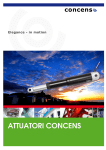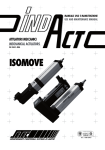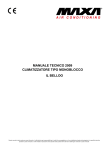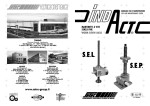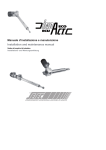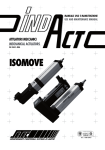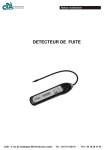Download Manuale d`installazione e manutenzione Installation and
Transcript
Manuale d’installazione e manutenzione Installation and maintenance manual • Codifica dell’attuatore Actuator designation Di seguito troverete la formulazione generale: You can see the general designation: 1 Tipo e grandezza Type and size 2 Tipo vite Screw type 3 N. micro fine corsa N. of limit switches ECO 1 - 2 - 3 MOT ECO 25 - 50 - 100 ECU 0 - 4 - 5 - 6 - 7 S - T LO S=Sfere / Ball screw T=Trapezia / Trapezoidal Tipo di motore Type of motor ECO 2-3-25-50-100 Motore lato opposto a disegni catalogo Motor on opposite side of catalogue drawings 10 Freno (motore autofrenante) Brake 11 Antirotazione Antirotation 12 Potenziometro (indicare 1kΩ, 5kΩ,10kΩ) Potentiometer (indicate 1kΩ, 5kΩ,10kΩ) 13 Manovra manuale** Manual operation** 14 ECO 25-50-100 Senza sporgenza vite senza fine No worm screw projection 15 Note speciali Special notes 16 2FC - 3FC* FR *Non disponibile per ECO25-50-100 / Not available for ECO 25-50-100 4 Solo per ECO1 Scatola FC ruotata 90° Only for ECO1 Limit switches box 90° rotated 5 Corsa in mm Stroke in mm 6 Forza nominale in (daN) Nominal force in (daN) 8 Tipo di attacco Type of connection 90° AR C PO 1* - 5* - 10* *Non disponibile per ECO 25-50-100 / Not available for ECO 25-50-100 V MM** Velocità nominale in (mm/s) Nominal speed in (mm/s) 7 9 **Non disponibile per motori DC e motori AC Grandezza 56 / Not available for DC motors and AC motors Size 56 F SSV A1 - A2 - A3 SP • Intermittenza di lavoro Duty cycle Tutti gli attuatori standard ECO ed ECU garantiscono le prestazioni nominali indicate nel nostro catalogo, ipotizzando un funzionamento intermittente con un fattore di servizio pari al 25% con un tempo totale ciclo di 5 minuti per ECO 1, 2, 3 e tutti i modelli ECU; e di 20% su 10 minuti per ECO 25, 50, 100; in assenza di urti e di vibrazioni, con carichi esclusivamente assiali ed ad una temperatura ambiente di 40°C. Per fattori di servizio diversi da quelli indicati consultare il nostro ufficio tecnico. ECO actuators guarantee the nominal performance indicated in our catalogne, with an intermittent duty of 25% over a total cycle time of 5 minutes for ECO 1, 2, 3 and all ECU models; and 20% over 10 minutes cycle time for ECO 25, 50, 100; without shock loads or vibrations, with only axial loads and at an environment temperature of 40°C. For service factors different from those indicated consult our technical office. • Regole base per il montaggio Basic mounting rules 1. L’attuatore è un componente atto a vincere SOLO ed ESCLUSIVAMENTE FORZE PURAMENTE ASSIALI (lungo l’asse dell’asta di spinta). Nessuna forza disassata o radiale è supportata dall’attuatore. The actuator is a component able to stand ONLY PURELY AXIAL FORCES (along the push rod). No out axial or radial forces can be supported. 2. Utilizzare solo perni cilindrici e fissare i perni su entrambe le estremità. Use solid pins only and fix the pins at both ends. • Temperatura ambiente di lavoro Working environment temperature e Min. –20 °C Max. +70 °C • Indice di protezione IP IP Rating Gli attuatori ECO-ECU standard hanno il seguente indice di protezione: • ECO con motori CC: IP 44 • ECO-ECU con motori AC senza fine corsa – potenziometro: IP 54 • ECO 2-3 ed ECU 0-4-5-6-7 con motori AC e fine corsa e/o potenziometro: IP 54 (a patto che il cliente sigilli con silicone il filetto della pressa cava in fase di cablaggio) • ECO 25-50-100 con fine corsa: IP 40 (può diventare IP54 utilizzando fine corsa IP54 e sigillando il filetto con silicone). The standard ECO-ECU actuators can be classified as follows: • ECO with DC motors: IP 44 • ECO-ECU with AC motors without limit switches-potentiometer: IP 54 • ECO 2-3 and ECU 0-4-5-6-7 with AC motors with limit switches and/or potentiometer: IP 54 (provided that the customer seals thread of wire presser with silicone during wiring) • ECO 25-50-100 with limit switches: IP 40 (it can become IP54 using IP54 limit switches and sealing the thread with silicone). • Cablaggio motore Motor wiring ATTENZIONE! Disattivare sempre l’alimentazione prima di operare sull’attuatore o di eseguire il cablaggio del motore. Installare sempre un fusibile e/o un interruttore termico tra il motore e l’alimentazione in modo da proteggere l’attuatore, il cablaggio ed altri componenti. CAUTION! Always turn the power off before working on the actuator or the wiring. Always install fuse and/or thermal breaker between motor and power supply to protect actuator, wiring and other items. a) Motori senza freno e motori autofrenanti tipo F ed FK con alimentazione unica Motors without brake and brake motors type F and FK with single power supply b) Motori autofrenanti tipo F con alimentazione separata (magnete AC trifase) Brake motors type F with separate power and brake connections. (three phase AC brake magnet) c) Motori autofrenanti tipo FK con alimentazione separate (alimentazione a richiesta – magnete freno DC alimentato tramite raddrizzatore) Brake motors FK type with separate power supply for motor and brake. (DC brake magnet with internal rectifiers) ESEMPIO DI COLLEGAMENTO MOTORE CON COMANDO TRAMITE I FINE CORSA. EXAMPLE OF CONNECTION OF A MOTOR WITH CONTROL THROUGH LIMIT SWITCHES 1. MOTORI CORRENTE CONTINUA D.C. MOTORS 2. MOTORI TRIFASE SENZA FRENO E CON FRENO CON ALIMENTAZIONE UNICA THREE PHASE MOTORS WITHOUT BRAKE AND WITH BRAKE WITH SINGLE POWER SUPPLY 3. MOTORI CON FRENO CON ALIMENTAZIONE SEPARATA ED ECCITAZIONE MANUALE (MOTORI TIPO FK63 PER VOLANTINO MANOVRA MANUALE) MOTORS WITH BRAKE WITH SEPARATE POWER SUPPLY AND MANUAL BRAKE UNBLOCKING (MOTORS TYPE FK 63 FOR MANUAL HAND WHEEL). 4. MOTORI MONOFASE SENZA FRENO E CON FRENO CON ALIMENTAZIONE UNICA SINGLE PHASE MOTORS WITHOUT BRAKE AND WITH BRAKE WITH SINGLE POWER SUPPLY • Fine corsa FC Limit Switches FC N F - Regolabili (opzione per ECO 1-2-3 ed ECU 0-4-5-6-7) In fig.1 troverete una raffigurazione utile per seguire la taratura. Per regolare la corsa dello stelo a valori desiderati, agire sulle camme come segue: 1) allentare le viti di fissaggio camme in modo da rendere le camme libere di ruotare attorno al loro asse; 2) ritrarre lo stelo traslante nella posizione desiderata; 3) ruotare la camma inferiore in senso antiorario fino a commutare il micro corrispondente; 4) serrare la camma in tale posizione mediante la vite corrispondente. Non stringere troppo la vite, per evitare il rischio di bloccaggio meccanico dell’asse di rotazione; 5) estendere lo stelo traslante nella posizione desiderata; 6) ruotare la camma superiore in senso orario fino a commutare il micro corrispondente; 7) serrare la camma in tale posizione mediante la vite corrispondente. Non stringere troppo la vite, per evitare il rischio di piantaggio dell’asse di rotazione. N W a Nota: queste operazioni vanno effettuate a motore o tramite manovra manuale qualora sia prevista. Attenzione: i fine corsa non vengono regolati in produzione ed è pertanto cura del cliente regolarli in base all’applicazione prima della messa in funzione. Evitare sempre di andare a fondo corsa meccanico dell’attuatore, pena la rottura di componenti meccanici e/o elettrici. Adjustable (option for ECO 1-2-3 and ECU 0-4-5-6-7) In fig.1 you can find the different parts necessary to adjust the limit switches. 1) Loosen the cam fixing screws so as to let the cams free to rotate around the shaft; 2) Put the pushing rod back in the desired position; 3) Rotate the lower cam counter-clockwise into contact with limit switch. (limit switch clicks). 4) Fix the cam in that position with its screw. Do not tighten the screw too much because the rotating shaft could block; 5) Move the pushing rod forward up to the desired position; 6) Rotate the upper cam counter clockwise into contact with limit switch (limit switch clicks); 7) Fix the cam in that position with its screw; do not tighten the screw too much because the rotating shaft could block. Note: this operations must be done with the motor or with the manual operation if available. Warning: limit switches are not adjusted in production, so the customer must adjust them before start-up. Always avoid to go against mechanical end of stroke, due to the risk of damage for mechanical and/or electrical components. • I - Non regolabili (opzione per ECO 25-50-100) In fig.2 troverete una raffigurazione utile per eseguire la taratura. 1) 2) 3) 4) Portare la camma interna in corrispondenza del foro della sede fine corsa inferiore ( dall’esterno si deve visualizzare la presenza della camma interna. Avvitare il fine corsa fino a battuta con la camma interna e tornare indietro posizionando il corpo fine corsa con il lato più lungo parallelo all’asse longitudinale dell’attuatore; Muovere l’attuatore avanti-indietro e controllare che il fine corsa scatti al passaggio della camma interna; se non dovesse scattare avvitare il fine corsa di 180° e riprovare. Continuare a step di 180° fino a far scattare il fine corsa. Fissare il fine corsa in posizione con il dado sullo stelo filettato del fine corsa. Realizzare la stessa operazione con il fine corsa superiore. Nota: queste operazioni vanno effettuate a motore o tramite manovra manuale qualora sia prevista. Attenzione: i fine corsa non vengono regolati in produzione ed è pertanto cura del cliente regolarli in base all’applicazione prima della messa in funzione. Evitare sempre di andare a fondo corsa meccanico dell’attuatore, pena la rottura di componenti meccanici e/o elettrici. A p m I A a Not Adjustable (option for ECO 25-50-100) Fig.2 is useful to regulate the radial position of the limit switches: 1) 2) 3) 4) i Move the internal cam below the lower limit switch holder, so that the internal cam can be seen from outside and through the hole of the limit switch holder; Screw the limit switch into the holder into contact with the internal cam. Turn back the limit switch so that the longer side of the limit switch body is parallel to the cover tube; Move the actuator forward and back to check if the internal cam actuates the limit switch in that position. If the limit switch does not work, screw it of 180° and try again. Keep trying at steps of 180° until the limit switch works. Block the limit switch in position with the nut on the threaded body of the limit switch. Repeat the same operation for the upper limit switch. Note: this operations must be done with the motor or with manual operation if available. Warning: limit switches are not adjusted in production, so the customer must adjust them before start-up. Always avoid to go against mechanical end of stroke, due to the risk of damage for mechanical and/or electrical components. i a i o a ù e e a i • Potenziometro PO (opzione per ECO 1-2-3 ed ECU 4-5-6-7) Potentiometer PO (option for ECO 1-2-3 and ECU 4-5-6-7) In fig.3 troverete una raffigurazione utile per eseguire la regolazione. 1) 2) 3) 4) 5) 6) Portare lo stelo dell’attuatore fino al fondo corsa inferiore (stelo retratto). Utilizzare i fine corsa previamente regolati quando disponibili. Allentare la vite di fissaggio della staffa potenziometro alla cassa. Il potenziometro rimane fissato alla staffa e sull’albero del potenziometro rimane fissato l’ingranaggio di trasmissione moto. Ruotare la staffa con il potenziometro in modo da scollegare la ruota potenziometro da ruota camme. Ruotare la ruota dentata e l’albero del potenziometro fino a leggere fra i contatti 1 e 2 un valore di resistenza minimo. Fissare di nuovo la staffa potenziometro facendo ingranare la ruota dentata dell’albero potenziometro con la ruota camme nella posizione scelta. Il valore di resistenza del potenziometro crescerà proporzionalmente con la corsa dell’asta traslante fino ad un massimo di resistenza da leggere fra i contatti 1 e 2 del potenziometro, con lo stelo attuatore tutto fuori. Attenzione: il potenziometro non viene regolato in produzione ed è pertanto cura del cliente regolarlo in base all’applicazione prima della messa in funzione. Evitare sempre di andare a fondo corsa meccanico dell’attuatore, pena la rottura di componenti meccanici e/o elettrici. In Fig.3 you can see a useful image to adjust the potentiometer: 1) 2) 3) 4) 5) 6) Take the rod of the actuator down to the lower stroke end. Use the previously adjusted limit switches if available. Loosen the fixation screw of the potentiometer clamp from the actuator case. The potentiometer is fixed to the clamp and on the potentiometer shaft is fixed the toothed wheel for the motion transmission. Rotate the clamp with the potentiometer so as to separate the potentiometer wheel from the cams wheel. Rotate the toothed wheel until a minimum value of resistance is measured between contact 1 and 2. Fix again the clamp into the chosen position. The resistance value of the potentiometer will proportionally grow with the stroke of the pushing rod, until a maximum that can be measured between contacts 1 and 2. Attention: the potentiometer is not adjusted in production, so the customer must adjust it before start-up. Always avoid to go against mechanical end of stroke, due to the risk of damage for mechanical and/or electrical components. • Manutenzione Maintenance Serie ECO Per le grandezze ECO1 ed ECO2 non è necessario provvedere a nessuna operazione di ingrassaggio. Per le grandezze ECO3, ECO25, ECO50 ed ECO100 è necessario provvedere periodicamente ad un ingrassaggio tramite gli ingrassatori predisposti sul tappo avvitato all’estremità dell’asta traslante e sulla cassa dell’attuatore. Come indicazione e per applicazioni normali si consiglia una carica di grasso (MOBILGREASE SPECIAL) ogni 500 ore di funzionamento. SERIE ECU Per le grandezze ECU0 ed ECU4 non è necessario provvedere ad alcuna operazione di ingrassaggio. Per le grandezze ECU5, ECU6 ed ECU7 è necessario provvedere periodicamente ad un ingrassaggio tramite l’ingrassatore predisposto sul tappo avvitato all’estremità dell’asta traslante. Come indicazione e per applicazioni normali si consiglia una carica di grasso (MOBILGREASE SPECIAL) ogni 5000 manovre oppure ogni sei mesi di funzionamento. ECO series Sizes ECO1 and ECO2 are greased for life. Sizes ECO3, ECO25, ECO50 and ECO100 have to be periodically greased through the proper greasers on the travelling rod end and the actuator case. Units for standard applications need a re-lubrication (MOBILGREASE SPECIAL) approximately every 500 working hours. ECU series Sizes ECU0 and ECU4 are greased for life. Sizes ECU5, ECU6, and ECU7 have to be periodically greased through the proper greaser on the travelling rod end. Units for standard applications need a re-lubrication (MOBILGREASE SPECIAL) approximately every 5000 manoeuvrings or every six working months. Cop ISOMOVE Manuale 2011:Cop ISOMOVE Manuale 19/10/11 11.30 Page 1 TORINO Direzione Generale e Stabilimento di Produzione - Headquarter and Production Plant Via Mappano, 17 - 10071 Borgaro T.se (TO) T +39 011 451 8611 (centr. r.a.) - F +39 011 470 4891 [email protected] MILANO Via Meccanica, 5 20026 Novate (MI) - Z. I. Vialba T +39 02 356 0990 - 382 01 590 (r.a.) F +39 02 356 0943 [email protected] ISTRUZIONI ECO-ECU REV01 ISTRUZIONI_ISOMOVE ITA/ENG REV02 07/2008 PADOVA Via Secchi, 81 35136 Padova T +39 049 872 5983 F +39 049 856 0965 [email protected] BOLOGNA Via Del Lavoro, 6/A 40051 Altedo (BO) T +39 051 871 949 (3 linee r.a.) F +39 051 870 329 [email protected] FIRENZE Via Galileo Galilei, 3 50015 Bagno a Ripoli - Grassina (FI) T +39 055 643 261 F +39 055 646 6614 [email protected] www.setec-group.it












